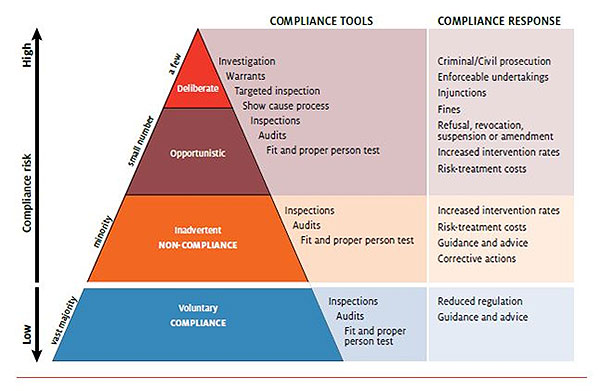GPAS 2016/10/001
This general practice administration statement is issued under the authority of the Director of Biosecurity. Department personnel, including non-ongoing staff and relevant contractors, must comply with this practice administration statement, unless doing so creates unintended consequences or is considered incorrect. Where this occurs, department personnel must follow their business line's escalation process.
Purpose of statement
To facilitate a smooth transition to the Biosecurity Act we are adopting a specific compliance posture to guide the implementation and operation of the new legislation in its early phase.
In line with the department’s approach to optimise voluntary compliance, we will work with clients, stakeholders and the community to raise awareness of any new obligations.
The compliance posture guides staff, industry and the general public in the application of the provisions of the Act from 16 June 2016.
Scope of statement
Our compliance posture is based on a phased implementation approach across a number of regulatory requirements and enforcement powers under the Act. The approach provides some concessions during a twelve month transition period from 16 June 2016, allowing time for people to adjust to the new operating environment.
Intent of statement
Our approach assumes that most people will comply, or try to comply, with their obligations. We adopt an educative (rather than punitive) response in the application of some provisions of the Act to support people to understand their obligations during the first twelve months from commencement. During this time we will continue to work towards improving our capacity to detect and respond to non-compliance, through monitoring and surveillance, intelligence gathering and data analysis, targeted campaigns and routine and random inspections and audits.

Principles we apply
- Where equivalent enforcement responses existed in the Quarantine Act 1908 and Biosecurity Act 2015, in the same area of the business then our approach will be to apply sanctions from commencement on 16 June 2016 (for example, infringement notices for airline passengers).
- Where new powers exist under the Biosecurity Act 2015, or are being applied to a new area of the business, then our approach will be to allow a transition period to adjust following commencement. During this time we will engage and educate clients to enable voluntarily compliance.
- Where the Biosecurity (Consequential Amendments and Transitional Provisions) Act 2015 provides for a transition period, existing clients will be transitioned to the new requirements as their existing authorisations expire. That is, no special arrangements will be made to accelerate the expiry of arrangements in order to enforce new requirements from commencement. In the case of locations such as first points of entry, new requirements will apply from the end of the transition period. For new clients/arrangements/locations, the new requirements will apply from commencement.
- Where the compliance posture allows for a period of adjustment, indications of deteriorating compliance or deliberate non-compliance will immediately result in the full application of the sanction powers provided within the Biosecurity Act 2015.
- The compliance posture does not in any circumstance limit the requirement of biosecurity officials or authorised officers to apply controls in order to manage real or suspected biosecurity risks.
The focus is on helping users understand their rights and responsibilities and verifying compliance with our systems. We will tailor our compliance responses to client behaviour to influence them in a positive way. We will analyse and assess the causes of non-compliance and take action to influence a positive change in client behaviour.
From 16 June 2016 we will monitor and respond to non-compliance in line with the department’s Biosecurity Compliance Statement 2016.
Transitional arrangements and a phased implementation
Where significant (or high impact) changes are anticipated under the Act, the Biosecurity (Consequential Amendments and Transitional Provisions) Act 2015 provides for additional periods from 16 June 2016, where users can transition to new requirements. This supports the department’s key approach to compliance management through encouraging voluntary compliance with regulatory requirements.
The focus leading into commencement is making sure clients and stakeholders understand and are able to comply with the new legislation. From commencement we will verify compliance with our systems and tailor our compliance responses to client behaviour to influence them in a positive way. Our approach will be to analyse and assess the causes of non-compliance and influence a positive change in client behaviour.
In considering how and when to apply the provisions of the Act, we will ensure that our regulation is proportionate to the level of risk, and that regulatory impact is minimised for compliant clients and stakeholders.
Amendment History
GPAS 2016/10/001
| Title | Date | Version |
|---|---|---|
| GPAS 2016/10/001 - Compliance Posture | 16 June 2016 | 1.0 (First time published) |
Date of Issue:
16 June 2016
Date of Effect:
16 June 2016
Authorised by:
Daryl Quinlivan, Secretary, Department of Agriculture and Water Resources
